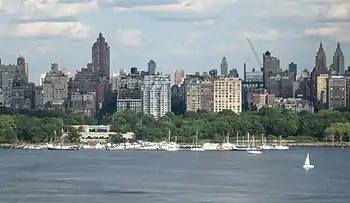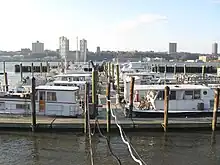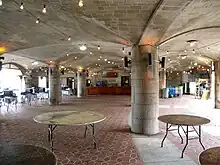
The 79th Street Boat Basin is a marina located in the Hudson River on the Upper West Side of the New York City borough of Manhattan, on Riverside Park at the foot of West 79th Street. Maintained and operated by the New York City Department of Parks and Recreation, it is the only facility in the city that allows year-round residency in boats, so it's known as a hub for houseboat living in NYC.[1][2]
History
Early history of the site
During the early years of New York City, the current site to Riverside Park was largely undeveloped, consisting of rocky outcroppings and steep bluffs along the Hudson River shoreline. Prior to European arrival, Native Americans sparsely populated this rough terrain.[3] In 1846 the Hudson River Railroad laid tracks across the Hudson River shoreline to speed the transport of goods from Albany to Manhattan. In 1865, William R. Martin, a commissioner on the Board of Central Park proposed a scenic drive and park along the Hudson River. During the next two years New York City acquired land between the Hudson River Railroad and the bluffs along the shoreline, and in 1873 the New York City Park Board commissioned Riverside Park. The co-designer of Central Park, Frederick Law Olmsted, was named lead designer. His design, which was accepted in 1875, included a winding drive for horses and sight-seeing, as well as pedestrian walkways, both accessible from the neighborhoods to the east.[4]
The park was completed by Olmsted's successor Calvert Vaux, but was soon surrounded by coal bins, shacks and garbage dumps.
Robert Moses era

By 1921, Riverside Park had deteriorated to an expanse of mud.[4] Barbed-wire fences cut the citizens off from the waterfront.[4] In the early 1920s, the architecture firm of McKim, Mead and White had submitted a proposal with an elevated traffic circle, covering the railroad tracks beneath. The traffic circle was partially built, and portions of a highway were also under construction on Manhattan's West Side. This drew the attention of citizens and politicians to this neglected area.[5]
The City of New York announced the West Side Improvement Project in 1934.[5][6] Robert Moses was at this time New York City's parks commissioner, and he took over the project. Moses expanded it into a grand architectural multi-level entry and exit from the Henry Hudson Parkway, all under the name of the "79th Street Grade Crossing Elimination Structure".[7][8] The multi-level structure was designed by Gilmore David Clarke. Moses was able to raise $109 million to begin the project,[9] for which the Works Projects Administration provided the equivalent of $103.8 million today.
Moses hired the architect and engineer Clinton Lloyd to work on the structural elements with the landscape architect, Gilmore Clarke, to work on the landscape.[10] The structure was built mostly from concrete, but the above-ground part is clad in cut stone. The initial McKim, Mead and White plan had called for rough-cut, dark stone to be applied to the exterior of the building, but Clinton Lyod modified their plan and used lighter, finer cut stone. The project created the Freedom Tunnel, an underground parking garage, a restaurant, and the marina. The rotunda was designed to hold the weight of the heavily used traffic circle that sits atop the building. The large support columns are visible inside the café.[11]
The 79th Street Rotunda and Boat Basin and the rest of the West Side Improvement Project were finished in 1937.[12]
Later years
By the 1960s, though the restaurant was long gone, the majority of slips were occupied by year-round boaters.[13] Year-round residents have included Mad Magazine writer Dick DeBartolo, who uses a boat as his office. Mario Puzo and Frank Sinatra have all used the basin to moor their boats.[13] In the 1960s, Roy Cohn docked his 95-foot (29 m) yacht here, and used it to entertain the city's political leaders.[14]
In 1979, the city sought to cancel a 1977 concession agreement with Nichols Yacht Yards to operate the marina, claiming that Nichols had underreported revenue and had acted as an "absentee slumlord". Boat owners would manage the marina until a suitable operator would be found.[15] Though Nichols obtained an injunction blocking the dismissal in December 1979,[16] the firm's operation of the facility ended in 1982, with Nichols having spent $250,000 in legal fees to battle the city and counter a rent strike by boat owners.[17]
In 1992, a five-year agreement was signed with boaters and the city, tying increases of nearly 25% in docking fees to improvements in facilities at the marina, such as new docks and electrical lines. By 1996, year-round residents had complained that the 18-month-long project, implemented at a cost of $1.4 million ($2.6 million today), had been done in shoddy fashion.[18]

The city stopped issuing new year-round permits in 1994, seeking to make space available for seasonal boaters among the basin's 116 slips. After complaints were received, the Parks Department agreed to an increase to 52 year-round spots, which start at a yearly fee of $5,000, based on the size of the boat.[1] By May 2009, the department was to require that all boats be seaworthy. As of February 2008, there were 19 boats that were considered unseaworthy and that would need to make operational "in case of an emergency evacuation".[13] By summer 2012, several boaters noticed that the basin was in a state of disrepair and asked the city to fix it.[19][20]
In June 2021, mayor Bill de Blasio announced that the city would collaborate with FEMA to overhaul the marina and rotunda; all existing tenants were required to leave by November 1, 2021.[21][22] At the time, the basin had not been dredged since 1958, and many of the marina's structures were dilapidated.[23] Work was scheduled to begin in 2023[22][23] and cost $90 million.[24][23]
Services
The Boat Basin is also used as a launch site for kayaks, canoes and sailboats. The Hudson River sloop Clearwater often docks here, as part of its mission of informing the public about environmental and pollution issues in the Hudson River.[25] As of May 2012, seasonal docking fees are $120 per linear foot (or a minimum of $3,000) for the summer (May 1 to October 31) and $105 per linear foot (or a minimum of $2,625) during the winter (November 1 to April 30).[26] Total dock fee revenue was over $240,000 in 2007, with more revenue taken in from the higher fees paid for part-time boaters. As of February 2008, there was a waiting list of 450 boaters seeking part-time docking privileges during the summer.[13] Fees were raised again in December 2011.[27]

A boat pump-out system connects directly to boats to allow for sewage disposal. Along with a fresh-water line system, the service is provided at no additional cost by the Parks Department. All other services, including electricity, telephone, television, and Internet access, must be paid for by boat owners, individually.[13]
Rules and regulations covering the 79th Street Boat Basin also apply at the Sheepshead Bay Piers and the World's Fair Marina.[26]
Adjacent rotunda
The 79th Street Rotunda, planned and built by former New York City Parks Department Commissioner Robert Moses during the West Side Highway's conversion into a parkway, is a traffic circle that sits next to the boat basin. between the Hudson River and the Henry Hudson Parkway at the western edge of 79th Street. The rotunda was built to allow easy access and exit to and from the Henry Hudson Highway. There are two ways to access the site by foot: one way is to walk along Riverside Park, and the other is to walk west on 79th Street. Drivers briefly drive atop the rotunda's traffic circle as they exit the Henry Hudson Parkway or enter the Parkway from 79th Street. The rotunda's interior, open-air courtyard is able to block noise and views of the highway, while blocking noise and views of the highway for the park and boat marina below. Moses viewed the project with grand monumentality, while believing it would add to the grandeur and allure of New York City as viewed from across the Hudson River from New Jersey's Hudson River Palisades. The Rotunda was a core part of the project.[28]

The structure is constructed primarily out of concrete. Above ground, the concrete is clad in cut stone to give the structure a smoothened-out look. Below ground in the parking garage, however, the concrete is more roughened. The rotunda was built to serve the double purpose of a transportation corridor and a recreational area; the two uses are visually separated into two vertical levels.[4] The 79th Street Rotunda allows easy access and exit to and from the Henry Hudson Highway. It allows trains on the West Side Line to travel into Manhattan via a tunnel called the Freedom Tunnel. It provides an internal, sheltered parking garage for boat basin users.[29]
The granite and fieldstone open rotunda surrounded by a vaulted Guastavino tiled arcade overlooks the marina, and was the site of the open-air O'Neals' West 79th Street Boat Basin Café.[25] The internal courtyard and seasonal café were added after the fact of initial design and conception.[30]
The 79th Street Rotunda and Boat Basin remain intact and have changed little since their construction, and the marina and restaurant are still in operation.[31] As well as ongoing uses, the rotunda hosted occasional theatrical performances[32] and art exhibits and has previously provided shelter at night for the homeless.[33]
Filming location
The Boat Basin has been a popular filming location. The Parks Department's web page for the basin lists details for obtaining film permits among things to do at the marina.[26] The 1986 film 9½ Weeks, starring Kim Basinger and Mickey Rourke, includes scenes shot at the marina and inside a houseboat moored there.[34] The 1998 film You've Got Mail has Tom Hanks and his relatives living on yachts in the basin.[35]
References
Notes
- 1 2 Hajela, Deepti via the Associated Press. "New York City marina living is shipshape" Archived October 12, 2012, at the Wayback Machine, The Washington Times, July 10, 2008. Accessed August 1, 2008.
- ↑ Jan 24, Ben YakasPublished; 2022Share (January 24, 2022). "The 79th Street Boat Basin Redesign Is Making Everyone Feel Seasick". Gothamist. Retrieved July 30, 2023.
{{cite web}}: CS1 maint: numeric names: authors list (link) - ↑ Jackson, Kenneth T. The Encyclopedia of New York City Archived March 16, 2022, at the Wayback Machine New Haven: Yale UP, 2010. Print.
- 1 2 3 4 Edward Grimm; E. Peter Schroeder (August 13, 2013). Riverside Park: The Splendid Sliver. Columbia University Press. pp. 5–12. ISBN 978-0-231-51219-0. Archived from the original on March 16, 2022. Retrieved September 13, 2022.
- 1 2 Cy A. Adler (2003). Walking Manhattan's Rim: The Great Saunter : Adventures and Discoveries on the Shores of the World's Richest, Most Varied Island. Green Eagle Press. pp. 49–. ISBN 978-0-914018-12-4.
- ↑ "WEST SIDE TRAFFIC TO RUN ON 4 LEVELS; Grade Elimination Structure at 79th St. Announced as Part of Park Plan. MOTORISTS TO BE AIDED Express Highway Will Pass Over Central Tracks With Pedestrian Arcade Below". The New York Times. June 15, 1934. Archived from the original on July 27, 2019. Retrieved July 27, 2019.
- ↑ Simpson, J.; Hern, M.E.W. (1981). Art of the Olmsted landscape: his works in New York City. New York City Landmarks Preservation Commission. p. 19. ISBN 978-0-941302-00-5. Archived from the original on September 13, 2022. Retrieved July 27, 2019.
- ↑ Caro 1974, pp. 553–554.
- ↑ Ballon, Hilary (2007). Robert Moses and the modern city : the transformation of New York. New York: W.W. Norton & Co. p. 20. ISBN 978-0-393-73243-6. OCLC 76167277.
- ↑ Caro 1974, p. 551.
- ↑ Henry Hudson Parkway Archived May 12, 2008, at the Wayback Machine.
- ↑ The New International Year Book. Dodd, Mead. 1938. p. 546. Archived from the original on March 15, 2022. Retrieved September 13, 2022.
- 1 2 3 4 5 Ramirez, Anthony. "For Perhaps $490 a Month, a Home on the Hudson River" Archived March 15, 2022, at the Wayback Machine, The New York Times, February 19, 2008. Accessed August 1, 2008.
- ↑ Montgomery, Paul L. "Roy Cohn finds politics brings new prominence" Archived September 13, 2022, at the Wayback Machine, The New York Times, February 19, 1981. Accessed August 1, 2008. "In the early 1960s, in his industrialist phase, when he had his 95-foot yacht Defiance berthed at the 79th Street Boat Basin, Mr. Cohn used to invite Carmine G. De Sapio and other Tammany Hall leaders out for cruises to talk over the perennial topics—who was in, who was out, who wanted what from whom."
- ↑ "Group of Boat Owners To Run Basin as City Acts to Oust Operator; Comptroller's Audits Critical" Archived March 15, 2022, at the Wayback Machine, The New York Times, November 4, 1979. Accessed August 1, 2008.
- ↑ Thomas Jr., Robert McG. "Boat Basin's Operator Blocks a City Attempt To Cancel Concession; 2 Avenues Open to City" Archived March 15, 2022, at the Wayback Machine, The New York Times, December 7, 1979. Accessed August 1, 2008.
- ↑ Tierney, John. "Manhattan Boat People: Lo Rnt, Riv Vu" Archived March 15, 2022, at the Wayback Machine, The New York Times, October 5, 1991. Accessed August 1, 2008. "Robert S. Bernstein, the president of Nichols Yacht Yards, which operated the boat basin from 1977 to 1982, said that his firm spent $250,000 in legal fees battling the city and tenants on the rent strike. 'It's the crummiest marina I have ever seen in my entire life," he said, blaming its deterioration on the city's refusal to raise rents to pay for improvements.'"
- ↑ Allon, Janet. "NEIGHBORHOOD REPORT: WEST SIDE;Residents Say Marina Isn't Shipshape" Archived March 15, 2022, at the Wayback Machine, The New York Times, January 28, 1996. Accessed August 1, 2008.
- ↑ "Crumbling 79th St. Boat Basin Docks Desperate for Repairs, Boaters Say - Upper West Side - DNAinfo.com New York". Archived from the original on June 10, 2013. Retrieved January 31, 2015.
- ↑ "Boat Basin Adrift: 79th Street dock residents worry over increased fees". Archived from the original on March 4, 2016. Retrieved January 31, 2015.
- ↑ Saltonstall, Gus (June 15, 2021). "79th Street Boat Basin In Riverside to be Rebuilt After 80 Years". Patch. Archived from the original on July 9, 2021. Retrieved July 3, 2021.
- 1 2 Velsey, Kim (July 2, 2021). "Twilight of the Liveaboards". Curbed. Archived from the original on February 26, 2023. Retrieved February 26, 2023.
- 1 2 3 "The 79th Street Boat Basin Redesign Is Making Everyone Feel Seasick". Gothamist. January 24, 2022. Archived from the original on February 26, 2023. Retrieved February 26, 2023.
- ↑ Mishkin, Mike (June 16, 2021). "NYC Announces $90 Million Restoration to 79th Street Boat Basin". iLovetheUpperWestSide.com. Archived from the original on February 26, 2023. Retrieved February 26, 2023.
- 1 2 History of the Park Archived September 28, 2008, at the Wayback Machine, Riverside Park Fund. Accessed August 1, 2008.
- 1 2 3 Rules Governing the West 79th Street Boat Basin, the Sheepshead Bay Piers and the World's Fair Marina Archived April 20, 2022, at the Wayback Machine, New York City Department of Parks and Recreation. Accessed April 7, 2015.
- ↑ "Proposed Boat Basin Fee Hike Makes Waves on Upper West Side - Upper West Side & Morningside Heights - DNAinfo.com New York". Archived from the original on March 11, 2016. Retrieved January 31, 2015.
- ↑ Caro, Robert A. The Power Broker: Robert Moses and the Fall of New York. New York: Vintage, 1975. Print.
- ↑ Engineering News Record. McGraw-Hill. 1937. p. 664.
- ↑ Simpson, Jeffrey, and Mary Ellen W. Hern. Art of the Olmsted Landscape: His Works in New York City. New York, NY: New York City Landmarks Preservation Commission, 1981. Print.
- ↑ Robin Lynn; Francis Morrone (August 5, 2013). Guide to New York City Urban Landscapes. W. W. Norton & Company. pp. 276–. ISBN 978-0-393-73357-0.
- ↑ Regional Theatre Directory. Dorset Theatre Festival & Colony House. 1996. p. 102. ISBN 9780933919341.
- ↑ Jennifer Toth (October 1, 1995). The Mole People: Life in the Tunnels Beneath New York City. Chicago Review Press. pp. 169–. ISBN 978-1-56976-452-7.
- ↑ "Archived copy". Archived from the original on August 5, 2021. Retrieved September 13, 2022.
{{cite web}}: CS1 maint: archived copy as title (link) - ↑ Maslin, Janet. "Film Review: You've Got Mail (1998)" Archived October 29, 2013, at the Wayback Machine, The New York Times, December 18, 1998. Accessed August 1, 2008. "Dabney Coleman and John Randolph play the much-married fathers, and at one point three generations of lonely male Foxes find themselves luxuriously ensconced on family boats at the 79th Street Boat Basin."
Sources
- Caro, Robert (1974). The Power Broker: Robert Moses and the Fall of New York. New York: Knopf. ISBN 978-0-394-48076-3. OCLC 834874.
- Fodor's (2005). New York State. Fodor's Travel Publications. pp. 45–. ISBN 978-1-4000-1378-4.
- Cy A Adler (April 16, 2012). Walking The Hudson: From the Battery to Bear Mountain (Second ed.). Countryman Press. pp. 61–. ISBN 978-1-58157-812-6.